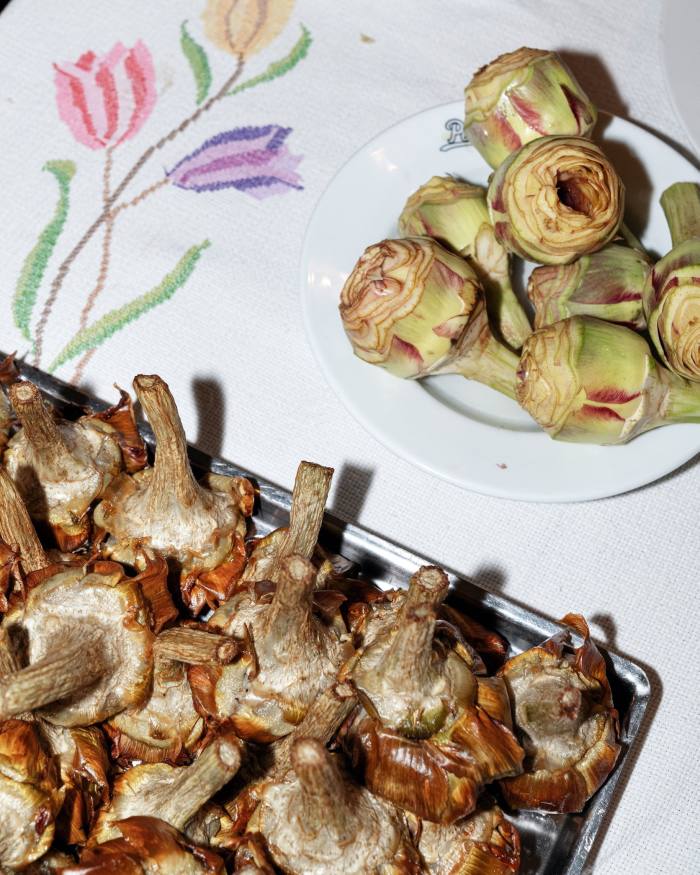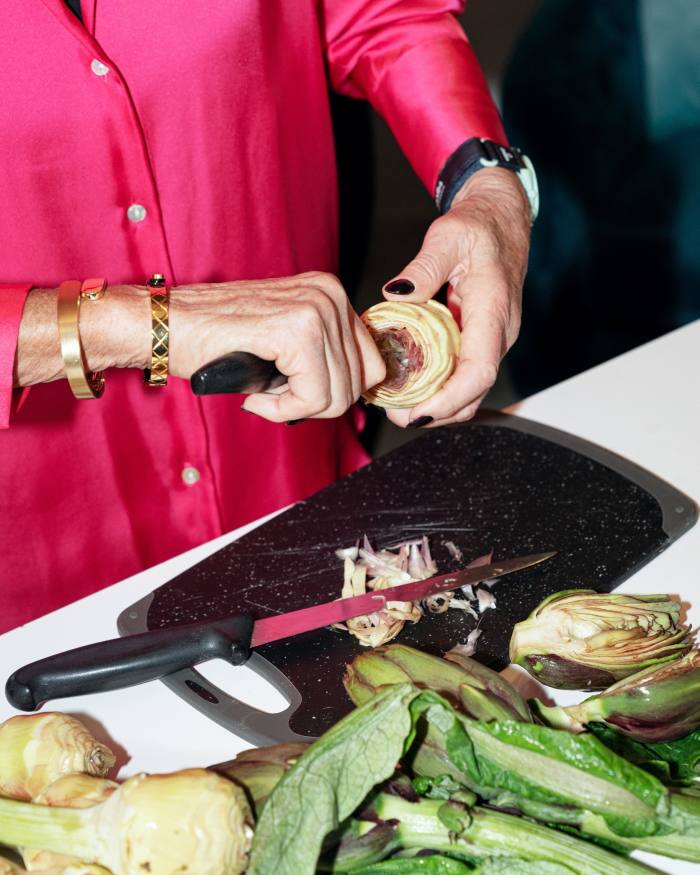This article is part of a guide to Rome from FT Globetrotter
In 77AD, Pliny the Elder extolled its aphrodisiac virtues. In 1547, Catherine de’ Medici introduced it to France and was said to have almost died of indigestion after eating one too many. And in 1954, Pablo Neruda, the Nobel laureate, wrote an ode singing its praises.
I am, of course, talking about Cynara cardunculus, named after the beautiful and unfortunate girl Cynara who, in a fit of rage and jealousy, was transformed by Zeus into what we now commonly know as the artichoke.
Il carciofo has for centuries been the undisputed king of Roman cooking, and it continues to adorn the menus and kitchens of the city’s restaurants from late November to April each year. It’s probably one of the most deliciously addictive flowers — for the artichoke is not strictly a vegetable.
Artichokes probably originated in ancient Egypt. In Arabic, they were named al-kharshuf (“prickly plant”) and quickly made their way to Rome.

How many times have you seen a lonely, sad-looking, bashed and bruised artichoke with thousands of food miles under its belt in a local London delicatessen and wondered to yourself how on earth one is supposed to cook it?
If you would like to find out, see the recipe for carciofi alla romana below by my mother Pamela McCourt Francescone who had to battle somewhat with the king when she first moved to Rome many moons ago, but having gained insider tips now makes the very best artichokes in my opinion!


For artichokes are winter plants that thrive on cold nights and sunny days, as Sergio, my local vegetable-stall keeper in Rome’s Magliana market, tells me. They are therefore perfectly placed to grow in the countryside around Rome and Lazio, the wider region that specialises in the cimaroli or mammole variety that tend not to have any of the choke that would normally need discarding. The truth is, they are difficult to cook and prepare, but it is a skill that Romans have in their DNA, somehow instinctively able to artfully transform this tough, hard and spiky-leaved flower into pure delight.
Come to Rome right now and you will see them cooked in many guises, but by far the two most popular ways are alla giudia, Jewish style, and alla romana. It is so hard to choose between them that I always order them both: alla giudia as a starter and alla romana as a side with my main course.
Where to eat carciofi alla giudia and alla romana in Rome
Carciofi alla giudia, as the name suggests, originate from Rome’s Jewish Ghetto, one of the oldest in the world, dating back to 1555 and nestled on the river Tiber between Trastevere and the Campidoglio.

Its preparation likely stems from the tradition of frying food during Hanukkah, which falls in the winter.
When I left Italy more than 20 years ago, you could only eat artichokes in the winter season; I recently saw tourists ordering them in the middle of August and nearly fell off my chair. When I enquired, the waiter told me that carciofi alla giudia have become so popular, and profitable for restaurateurs, that they now import artichokes all year around. Frankly, I cannot abide eating them out of season, and you will be hard pressed to find Romans cooking them or eating them outside winter — and, if you care about food miles, nor should you.
Giggetto al Portico d’Ottavia
21/a Via del Portico d’Ottavia, 00186 Rome
-
Good for: A feel for the historic Jewish Ghetto and stepping back in time
-
Not so good for: A fun night out on the town
-
FYI: Order a delicious mozzarella- and anchovy-stuffed fried fiore di zucca (courgette flower) to go with your carciofo alla giudia as a starter
The best place, in my opinion, to try these crispy, made-to-perfection flowers is in the heart of the ghetto at Giggetto al Portico d’Ottavia, a restaurant that since 1923 has fried more than 300 artichokes every day when in season.


For this time-honoured version, the artichoke, duly cleaned and freed of at least half of its outer leaves, is first fried in medium-hot olive oil for 10 minutes to tenderise the core and then flash-fried in searing-hot oil a second time just before serving it. The heat makes the flower bloom into an amazing work of art reminiscent of one of Van Gogh’s paintings.
I can guarantee you that, sprinkled with salt and piping hot, they are one of the most glorious foods you will eat, crispy on the outside and lusciously tender on the inside. I know of people who, from never having eaten an artichoke before, become addicted to them after visiting Rome.
Pianostrada
22 Via delle Zoccolette, 00186 Rome
-
Good for: Celebrity spotting and a special night out
-
Not so good for: A cheap and cheerful snack
-
FYI: Choose between dining at the open-kitchen counter, the gorgeous living room or the alfresco patio


If you’re looking for a high-end, modern take on Roman cooking in a very elegant setting, head to Pianostrada. Here the four women founders, headed by chef Paola Colucci, have taken the Roman restaurant scene by storm, revisiting all the classics with innovative preparation. Try the lovely beef tagliata served with a carciofo cooked half alla giudia and half alla romana, with an unctuous pecorino emulsion.
Jacopa
7 Via Jacopa de’ Settesoli, 00153 Rome
-
Good for: Rome’s best organic and natural wine list
-
Not so good for: A quick bite to eat with the kids
-
FYI: In the summer, check out the beautiful rooftop cocktail terrace


Wander down the streets of Trastevere to Jacopa, the restaurant of the Hotel San Francesco, which is known for its experimental cuisine. Here you must try one of the staples of Rome’s quinto quarto (“fourth-fifth”), otherwise known as offal cuts, skilfully prepared for centuries by thrifty Romans. One of Jacopa’s specialities is coratella, a minutely diced mix of lamb’s liver, heart and lungs pan-fried with artichokes into a rich concoction and served on a slice of warm bruschetta. Stay for one of the incredible desserts and finish off the evening with Cynar on the rocks, an amaro digestivo made from an infusion of — yes, you guessed it — artichokes, and which has an earthy, gently bitter aromatic flavour.
Pecorino
64 Via Galvani, 00153 Rome
-
Good for: Hearty, family-style Roman classics
-
Not so good for: A candlelit romantic supper
-
FYI: Try one of Rome’s most traditional dishes, coda alla vaccinara: oxtail braised in a tomato sauce


For a hearty dinner before hitting the wine bars and nightclubs of Testaccio, head to this classic, old-style trattoria. As well as finding artichokes cooked in the two stalwart styles, try the maltagliati con carciofi. This dish consists of homemade, rustic pasta that is roughly and unevenly shaped (maltagliati means “badly cut”), smothered in a sauce of braised sliced artichokes and pecorino. And if you want to dare a trifecta of artichokes after your carciofo alla giudia for a starter and maltagliati as pasta course, go for the succulent breaded and fried spring-lamb cutlets served with more artichokes.

By now your encounters with Rome’s culinary king will surely leave you as hooked on il carciofo as Queen Catherine de’ Medici, and you will be hankering for more of the Eternal City’s wonderfully crisp and sunny blue-skied winter days that prove so fertile for one of civilisation’s oldest and most noble of flowers.
Recipe: braised carciofi alla romana
by Pamela McCourt Francescone


The first time I cooked artichokes, I had been living in Rome for only a few months and was enthusiastically trying out exciting new foods and recipes. But my artichokes came out so bullet-hard that I tossed them straight into the bin and thought, well, never again.
When I told my housekeeper Signora Tina, she laughed and told me her two secrets for buttery-soft Roman-style artichokes. “The first,” she said, “is to remove more of the hard external leaves than you think is wise. And the second is to pour in more top-quality extra-virgin olive oil than you can afford.”
To serve four you will need:
-
8 artichokes
-
4 cloves of garlic, finely chopped
-
1 lemon
-
60ml dry white wine
-
250ml extra-virgin olive oil
-
2 tbsp chopped parsley
-
2 tbsp chopped spearmint or mint
-
Salt
1. Remove the outer layers of the artichokes, pulling them downwards with a snap until you are left with only the pale-yellow inner leaves, and a considerably reduced artichoke.
2. With a serrated knife, make a curved cut around the top to trim off any straggling tips, and then a straight cut so they will stand upright in the pot. Cut the stem to 5cm and pare away the outer layer.
3. As you finish each step, liberally rub the artichokes with half a lemon, or pop them into a bowl of water with lemon juice to stop them from turning brown.
4. Ease open the top of the artichoke with your fingers and, using a small spoon or paring knife, remove the hairy core at the bottom, if present. These are the embryonic petals of the artichoke flower that would bloom into a delightful purple if left to grow.
5. Gently heat the oil in a pot of just the right size to hold the artichokes standing up and packed closely together. Push the chopped garlic, parsley and spearmint between the leaves, and place them head down in the pot, with the stems pointing upwards. Make sure the oil covers at least half the height of the artichoke bulbs.
6. Add the juice of half a lemon, the wine and a sprinkle of salt and cover the pot first with a brown paper bag, to help seal in the juices, and then a lid.
7. Simmer for 30-35 minutes until fork-tender. Remove carefully from the pot and place standing upright on a serving dish. Sprinkle with chopped parsley and pour the cooking oil over them so they are swimming in a sea of golden, green-speckled juices.
They are at their best eaten hot or warm and served with bruschetta, but can also be enjoyed cold the next day.
Where were the best artichokes you have ever eaten in Rome? Tell us in the comments
Follow FT Globetrotter on Instagram at @FTGlobetrotter



